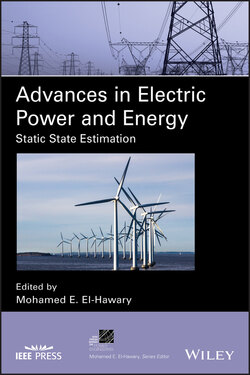Читать книгу Advances in Electric Power and Energy - Группа авторов - Страница 73
2.5.11 Results
ОглавлениеThe estimation problems previously mentioned are solved by using optimization software and by considering that parameters M and T are set to 100 and 2, respectively. The maximum number of iterations and the duality gap for MINLP problems is set to 1000 and 1%, respectively.
In order to remove mathematical unfeasibilities, the solutions to LMS and LTS mathematical problems are obtained by imposing that the set of measurements whose residuals are smaller than ∣yν( x )∣ provides whole system observability. This observability is achieved by forcing some binary variables to be equal 1 (i.e. bi = 1). These fixed variables correspond to a set of voltage and active power flow measurements that make the system observable.
Both numerical accuracy and computation performance are analyzed and compared. Tables 2.14 and 2.15 and Figures 2.13–2.15 provide results regarding estimation accuracy and computational performance:
Table 2.14 provides the mean and standard deviation of metrics and for each estimator considered.
Table 2.15 provides the minimum, mean, maximum, and standard deviation for the CPU time required (measured in seconds) for each estimator.
Figure 2.13 depicts the histogram of voltage magnitude absolute error for each estimator considered.
Figure 2.14 likewise shows the histogram of voltage angle estimation accuracy (measured in terms of absolute error ) for each estimation technique.
Finally, Figure 2.15 provides the histogram of the CPU time required (measured in seconds) for each estimation procedure.
TABLE 2.14 Case study: estimation accuracy results.
| Method | (p.u.) | (p.u.) | (rad) | (rad) |
|---|---|---|---|---|
| WLS | 0.0015 | 0.0012 | 0.0019 | 0.0015 |
| LAV | 0.0019 | 0.0015 | 0.0023 | 0.0018 |
| QC | 0.0017 | 0.0013 | 0.0020 | 0.0016 |
| QL | 0.0016 | 0.0012 | 0.0019 | 0.0015 |
| LMS | 0.0095 | 0.0083 | 0.0052 | 0.0043 |
| LTS | 0.0053 | 0.0052 | 0.0029 | 0.0024 |
| LMR | 0.0015 | 0.0012 | 0.0019 | 0.0015 |
TABLE 2.15 Case study: computational performance results.
| Method | Minimum (s) | Mean (s) | Maximum (s) | Std. dev. (s) |
|---|---|---|---|---|
| WLS | 0.84 | 0.96 | 1.37 | 0.09 |
| LAV | 0.37 | 0.56 | 0.76 | 0.07 |
| QC | 0.17 | 0.24 | 0.37 | 0.04 |
| QL | 0.84 | 1.04 | 1.54 | 0.14 |
| LMS | 3.56 | 5.05 | 8.39 | 0.85 |
| LTS | 1.00 | 1.25 | 1.87 | 0.16 |
| LMR | 0.81 | 5.01 | 24.39 | 6.02 |
Figure 2.13 Histogram of voltage magnitude estimation accuracy for each method.
Figure 2.14 Histogram of voltage angle estimation accuracy for each method.
Figure 2.15 Histogram of the computation time for each estimator.
In Tables 2.14 and 2.15 and Figures 2.13–2.15, we can observe the following:
1 In terms of estimation accuracy, the WLS, QC, QL, and LMR procedures are more precise than the other procedures in estimating both voltage magnitudes and angles. On the other hand, the accuracy provided by the LMS algorithm is worse than that provided by other estimators.Note that the absolute errors are notably small for all the estimators, with the exception of the LMS and LTS approaches, whose absolute errors are five and three times higher than those of other procedures.Note also that the accuracy variability of the LMS estimator is high for both the magnitude and the angle estimates.
2 From the computational point of view, the LAV and QC approaches are more efficient than the other procedures. Observe that these two techniques slightly outperform the conventional WLS method. However, the LMS and LTS methods require a larger amount of CPU time, owing to the non‐convexities of their mathematical programming formulations and the non‐differentiable objective functions.
In Figure 2.15, note that the variability of the computation time required for the LMR procedure is significantly high, but its average value coincides with that of the LMS technique.
